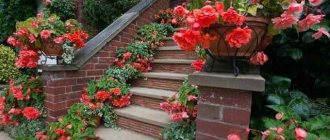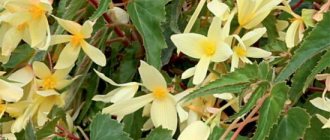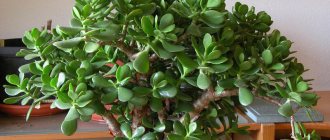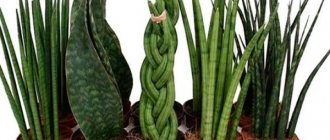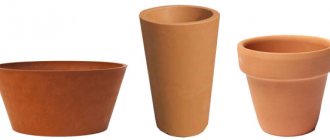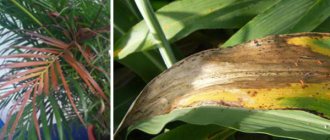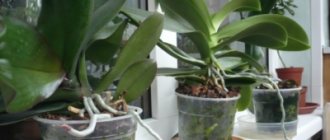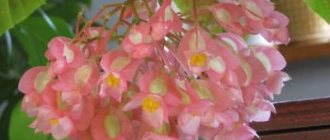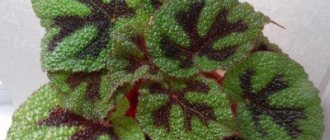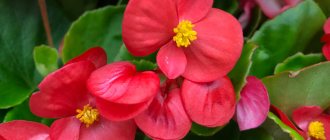Home care for Begonia hogweed
Lighting
Bright, mostly diffused light is required. The best lighting will be provided by windows facing east or west .
On the south and southeast side, shading may be required - especially in midsummer, when the leaves - the main decoration of this begonia - can lose color and get burned.
Temperature
The optimal temperature range throughout the year is from 18 to 22 degrees.
In winter, the temperature should not fall below 15 degrees.
The forced period of relative rest in indoor culture - from the end of October to the end of February - is associated mainly with a decrease in illumination.
Priming
This begonia does not have any special requirements for the soil substrate: it must be neutral or slightly acidic, sufficiently loose, nutritious, with good air and moisture permeability .
You can use ready-made soil for begonias , or garden soil with a good dose of perlite or vermiculite, and also prepare a mixture of equal parts of leaf soil, humus and sand.
Landing
The root system develops in the surface layer of soil. In addition, the lodging stem forms additional roots where it comes into contact with the soil and the bush grows in breadth. Therefore, planting container wide rather than deep , with a mandatory drainage hole . Since stagnation of water is extremely unfavorable, it is better to choose a porous container material - ceramics without a continuous layer of glaze .
a drainage layer must be placed , then a small layer of soil, on top of which the root system is placed, preserving the earthen ball if possible , and the soil mixture is added to the required level, gradually compacting it.
growing point should be above the soil surface .
Transfer
Young specimens require annual replanting , mature ones - after a year or two, as they grow, propagating by dividing the bush.
Watering
Water moderately after the top layer of soil dries.
In winter, the frequency of watering should be reduced .
Air humidity
It is necessary to maintain an atmosphere of high humidity , similar to the “native” subtropics, but direct spraying of the bush will damage the leaves : dark spots appear on them.
Place the container on a tray with moistened pebbles (expanded clay) or spray only the air surrounding the plant.
Botanical description
Begonia heracleifolia – hogweed begonia – is a plant from the begoniaceae family. Originally from the tropics of South America. This is a herbaceous plant with a thick stem lying on the ground. The leaves are on succulent long petioles; the shape, as the name implies, resembles the leaves of Sosnovsky's hogweed or a palm with outstretched fingers. Green leaves with lighter veins on them and reddish cuttings are the main advantage of this begonia; they provide its decorative value. The underside of the leaves is pubescent, pale green or brownish-red. You will learn about all types of decorative deciduous begonias in a separate article.
Begonia hogweed blooms with pinkish flowers collected in a brush on a high peduncle. Flowering - from February to April. The flowers are pleasant to look at, but some experts recommend removing the flower stalks so as not to take away the vitality of the beautiful large leaves. The plant reaches a height of up to 40 cm, and in the volume of the bush - up to 60-70 cm.
There is also a variety of this begonia - blackish hogweed (Begonia heracleifolia var, nigricans). It has very dark leaves with light green veins. Also a very interesting decorative variation.
Reproduction
Begonia hogweed is propagated by both vegetative and seed methods .
Reproduction by leaf and stem
Use spring and summer cuttings about 10-15 cm long, which have a leaf. The sections are dried.
You can pre-root the cuttings in water, treat the lower cuts with rooting stimulants, or immediately plant them in regular soil with additional sand.
The planting is covered with plastic film, kept warm (+ 22-25ºС ), ventilated and moistened.
After the formation of the root system and the formation of new shoots (within about a month ), the cuttings are planted in separate containers with a regular soil mixture.
Propagation by leaf cuttings
Take a large, well-formed sheet, spread it on a hard, smooth surface (on glass) and with a sharp blade divide it from the center into segments so that each part has one or two vascular veins .
The resulting parts are laid out on the surface of the soil (the lower ends can be slightly buried), moistened, covered with plastic film, moistened, ventilated and kept at a temperature of 20-22 degrees.
Within a month, the begonia will be reborn even with such “dismemberment” and will form small new leaves in the places where the veins are cut .
Reproduction by dividing the bush
As a rule, hogweed begonia grows greatly in breadth . When replanting in spring, you can divide this powerful, spread-out bush with a sharp tool into several parts with root systems , sprinkle the sections with crushed charcoal and plant them in separate containers.
Propagation by seeds
This method is more often used for propagating beautifully flowering begonias, but begonia hogweed seeds (a mixture of varieties) are also commercially available.
At the end of winter, small seeds are placed on the surface of the soil mixture, sprayed with water, covered with plastic film, ventilated, and kept at a temperature of 22-25ºC and good lighting .
Shoots, as a rule, appear after 2-3 weeks.
After the formation of two or three true leaves, the seedlings carefully dive, reduce the temperature to 17-18ºC and limit watering .
As they grow, they are seated.
Also on our website there are articles about other varieties of begonias: Cleopatra, Bauer, Masona, Royal, Spotted, Collared and Red-leaved.
Landing requirements
First, let's describe everything in general terms. In principle, planting any ornamental plant is a troublesome task, but when planting our guest, who is also called the “unpretentious foreigner,” it is worth observing strict requirements. For example, the problem may not be germination associated with freezing of tubers. When purchasing, you should pay attention to the presence of rot on the glomerulus . Small roots can be removed from the tuber. It should be processed in a special liquid.
The pot should not be deep, as the roots will not be long in the future. Drainage must be placed at the bottom of the pot. Drainage should not fill more than 10% of the pot's volume.
The soil should be loose and also have a large amount of air . You can buy such land in specialized stores. Debris such as pebbles or sticks must be removed. There is no need to crush the soil; the looser it is, the better. It wouldn't hurt to add vermiculite. There is no need to deepen the tuber much; relatively speaking, the tuber sits “up to the shoulders.” Until the begonia gets stronger, watering is carried out along the edge. Do not cover dishes to create excess moisture.
Watch a video about transplanting hogweed begonia:
This begonia loves bright and diffused sunlight, or you can place the plant in partial shade. Under no circumstances should begonia be exposed to direct sunlight; it is harmful to it and can lead to the death of the plant.
The soil, as for all other begonias, should be loose and enriched with various microelements.
Peat and black soil can be added to the ground in a one to one ratio .
You can purchase the soil at any flower shop, or mix it yourself. Adult begonia is not particularly picky about the soil, but when planting and germination, the soil should be loose, have a large supply of oxygen, and should also be enriched with minerals and trace elements. Soil is one of the most important factors affecting the beauty of your begonia.
Signs of trouble
The leaves turn pale, the shoots stretch out - the result of insufficient lighting, especially in winter. It is necessary to organize additional illumination during the short daylight hours.
The edges of the leaves turn brown and dry - dry air and overheating. Exposure to direct sunlight should be limited and the air humidified.
The leaves lighten, and brown dry areas appear on them - sunburn. It is necessary to reduce the “dose” of direct sunlight.
Optimal growing conditions
In order for indoor flowers to develop harmoniously and delight with the diversity of their large foliage, they need to create conditions close to their habitat. We are talking about appropriate temperature and humidity conditions, as well as lighting and soil composition.
Soil requirements
The quality of the substrate is one of the most important factors that determine the growth of the plant, therefore, for planting home begonias, loose and nutritious soil with excellent water and air permeability is preferable.
In the case of preparing the earth mixture yourself, it is recommended to combine equal parts of fertile chernozem (extracted from a depth of 20 cm), deciduous soil and high-moor peat. In order to prevent rapid evaporation of moisture, it is advisable to add a little vermiculite to the soil mixture. And do not forget about the drainage layer, which should not exceed 10% of the volume of the planting container.
Keep in mind that young seedlings have special requirements for potting soil, so when rooting them, do not compact the top layer under any circumstances. The more loose it is, the better the sprout will develop.
Lighting and daylight hours
It is better to place a pot with begonia in a well-lit area with diffused rays . To do this, it is not necessary to choose sides with a southern orientation, since the plant is afraid of the scorching sun. He will be comfortable in rooms with windows facing east and southwest.
If the flowerpot is in partial shade, its foliage will acquire a denser color and be covered with brown-red veins. This arrangement will not at all harm the splendor of the begonia crown and the size of its leaf plates. It is advisable that the daylight hours for the plant last at least 12 hours, otherwise its biomass will lose volume and fade.
Temperature and humidity
In conditions of excessive heat or cold, it is impossible to achieve a luxurious appearance of a flower. In the first case, the tips of its leaves will dry out and begin to curl, and in the second, the flowerpot will stop its development and may even die.
The optimal temperature for the harmonious development of the crop is + 18 ... + 22 ° C with a humidity of 60%. It is important that in winter, when a period of stagnation sets in, the thermometer in the room does not fall below the minimum markings. Otherwise, the cold-sensitive begonia will disappear.
In the warm season, especially in hot weather, it is recommended to spray the air near the plant, protecting it from water. Drops on foliage and inflorescences can result in the appearance of unsightly brown spots.
Keep in mind that this variety is moisture-loving. But a sense of proportion is of enormous importance. With excess moisture, rot quickly develops on the roots of a flower, and it is not always possible to save it. Experienced flower growers advise periodically humidifying the air in the room or placing a container filled with water near the pot.
Diseases and pests
Maintenance errors, primarily stagnation of moisture in winter or lack of it in summer, weaken the plant and provoke its defeat by powdery mildew . In this case, you need to optimize watering and treat the begonia with fungicides.
The combination of high humidity and low temperature leads to the development of root or leaf rot .
If the process has just begun, you should urgently optimize the temperature and humidity conditions and remove damaged parts.
In case of severe damage, you will have to root cuttings cut from healthy shoots or leaves and keep them in appropriate conditions, and get rid of the rest of the plant.
Begonia can be attacked by whitefly and mealybug . As a first measure, remove pests using a cotton swab dipped in alcohol or treatment with a soap solution. The most effective pest control is systemic insecticides.
Begonia hogweed is one of the most undemanding and hardy decorative deciduous representatives of this genus (read about caring for decorative deciduous varieties here).
Begonia hogweed disinfects the room in which it grows : in its presence, the content of staphylococci and spores of pathogenic fungi in the air decreases .
Decorative deciduous begonia - care and propagation
Do you have an ornamental begonia? Care at home must be thought out! This is an amazing house plant, stunning with its beauty, patterns on the leaves, refreshing the air in the house quite unpretentiously, but still requires proper care. In this article we will tell you about all the little things you need to know for this.
Let's get acquainted
To understand exactly how to care for begonia, it would be useful to find out in more detail what kind of flower it is. “Napoleon's Ear,” as it is popularly called, began to occupy window sills four centuries ago. The flower gained its popularity due to its unpretentiousness, ease of reproduction and, of course, beauty. Who would know, but the plant got its name in honor of M. Begon, who was the governor of Haiti in those distant times. Begonia hogweed also belongs to the decorative subspecies. Caring for her at home is no different from caring for her more famous sister.
The flower has gained its popularity due to its unpretentiousness, ease of propagation and, of course, beauty.
It is impossible to count how many other relatives of the heroine of our article exist by this time, and they are divided into decorative flowering and decorative deciduous. The latter received their name for their amazingly beautiful foliage. There is also a minus - the flowers of such begonias do not come out very well.
about decorative deciduous begonia, part 1
Humidification and lighting
Some may think that flowers that come from hot tropical places need plenty of sunlight...and they would be wrong. After all, flowers are not trees, they grow below, and do not receive much sunlight, unlike water. Begonias are just like that - excess sunlight burns them, but they constantly need moisture.
That’s why they feel good in the summer on a southwestern or southern windowsill. When the apartment is heated in winter, place wet towels on the radiators next to the begonias - this will make the air around it less dry.
You can install reservoirs with warm water around the plants, but you can also get an air humidifier or a decorative fountain, placing it nearby.
Begonia leaves love to be watered with lukewarm water.
Indoor plants in our region, including begonia hogweed, know what a dry, warm winter is like on the windowsill. Look at the color of your green pet's leaves. The less green it contains and the more bright colors it contains, the more difficult it is to care for such a plant. For royal begonias, spraying with fresh water is quite enough; they especially like this in winter. However, many subspecies will feel better in a florarium, where all the conditions to which they are accustomed are met. A film draped over the soil to retain more moisture is also suitable.
Begonia leaves love to be watered with lukewarm water. However, do not leave them in a draft, otherwise they will rot. They also do not like open sunlight - in this case, burns are inevitable.
Photo
Next you will see a photo of begonia hogweed:
The soil
The soil, as for all other begonias, should be loose and enriched with various microelements. Peat and black soil can be added to the ground in a one to one ratio .
You can purchase the soil at any flower shop, or mix it yourself. Adult begonia is not particularly picky about the soil, but when planting and germination, the soil should be loose, have a large supply of oxygen, and should also be enriched with minerals and trace elements. Soil is one of the most important factors affecting the beauty of your begonia.
